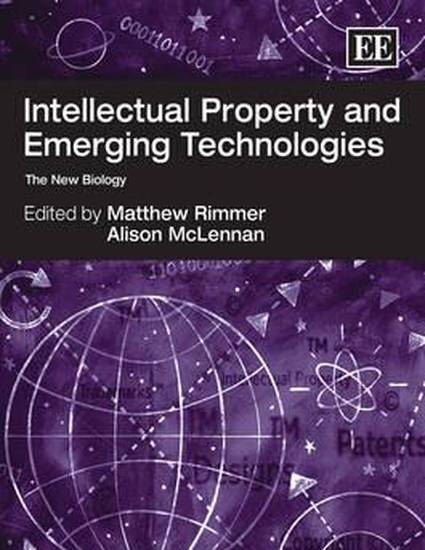
Contribution to Book
Inventing Life: Intellectual Property and the New Biology
Intellectual Property and Emerging Technologies: The New Biology
(2012)
Abstract
In 2009, the National Research Council of the National Academies released a report on A New Biology for the 21st Century. The council preferred the term ‘New Biology’ to capture the convergence and integration of the various disciplines of biology. The National Research Council stressed: ‘The essence of the New Biology, as defined by the committee, is integration—re-integration of the many sub-disciplines of biology, and the integration into biology of physicists, chemists, computer scientists, engineers, and mathematicians to create a research community with the capacity to tackle a broad range of scientific and societal problems.’ They define the ‘New Biology’ as ‘integrating life science research with physical science, engineering, computational science, and mathematics’. The National Research Council reflected:
'Biology is at a point of inflection. Years of research have generated detailed information about the components of the complex systems that characterize life––genes, cells, organisms, ecosystems––and this knowledge has begun to fuse into greater understanding of how all those components work together as systems. Powerful tools are allowing biologists to probe complex systems in ever greater detail, from molecular events in individual cells to global biogeochemical cycles. Integration within biology and increasingly fruitful collaboration with physical, earth, and computational scientists, mathematicians, and engineers are making it possible to predict and control the activities of biological systems in ever greater detail.'
The National Research Council contended that the New Biology could address a number of pressing challenges. First, it stressed that the New Biology could ‘generate food plants to adapt and grow sustainably in changing environments’. Second, the New Biology could ‘understand and sustain ecosystem function and biodiversity in the face of rapid change’. Third, the New Biology could ‘expand sustainable alternatives to fossil fuels’. Moreover, it was hoped that the New Biology could lead to a better understanding of individual health: ‘The New Biology can accelerate fundamental understanding of the systems that underlie health and the development of the tools and technologies that will in turn lead to more efficient approaches to developing therapeutics and enabling individualized, predictive medicine.’
Biological research has certainly been changing direction in response to changing societal problems. Over the last decade, increasing awareness of the impacts of climate change and dwindling supplies of fossil fuels can be seen to have generated investment in fields such as biofuels, climate-ready crops and storage of agricultural genetic resources. In considering biotechnology’s role in the twenty-first century, biological future-predictor Carlson’s firm Biodesic states: ‘The problems the world faces today – ecosystem responses to global warming, geriatric care in the developed world or infectious diseases in the developing world, the efficient production of more goods using less energy and fewer raw materials – all depend on understanding and then applying biology as a technology.’
This collection considers the roles of intellectual property law in regulating emerging technologies in the biological sciences. Stephen Hilgartner comments that patent law plays a significant part in social negotiations about the shape of emerging technological systems or artefacts:
'Emerging technology – especially in such hotbeds of change as the life sciences, information technology, biomedicine, and nanotechnology – became a site of contention where competing groups pursued incompatible normative visions. Indeed, as people recognized that questions about the shape of technological systems were nothing less than questions about the future shape of societies, science and technology achieved central significance in contemporary democracies. In this context, states face ongoing difficulties trying to mediate these tensions and establish mechanisms for addressing problems of representation and participation in the sociopolitical process that shapes emerging technology.'
The introduction to the collection will provide a thumbnail, comparative overview of recent developments in intellectual property and biotechnology – as a foundation to the collection. Section I of this introduction considers recent developments in United States patent law, policy and practice with respect to biotechnology – in particular, highlighting the Myriad Genetics dispute and the decision of the Supreme Court of the United States in Bilski v. Kappos. Section II considers the cross-currents in Canadian jurisprudence in intellectual property and biotechnology. Section III surveys developments in the European Union – and the interpretation of the European Biotechnology Directive. Section IV focuses upon Australia and New Zealand, and considers the policy responses to the controversy of Genetic Technologies Limited’s patents in respect of non-coding DNA and genomic mapping. Section V outlines the parts of the collection and the contents of the chapters.
Keywords
- Intellectual Property,
- Emerging Technologies,
- Converging Technologies,
- Genetics,
- Stem Cell Research,
- Synthetic Biology,
- Nanotechnology,
- Biodiscovery,
- Clean Technologies.
Disciplines
Publication Date
January, 2012
Editor
Matthew Rimmer and Alison McLennan
Publisher
Edward Elgar
ISBN
978 1 84980 246 8
Citation Information
Alison McLennan and Matthew Rimmer. "Inventing Life: Intellectual Property and the New Biology" Cheltenham (UK) and Northampton (Mass.)Intellectual Property and Emerging Technologies: The New Biology (2012) Available at: http://works.bepress.com/matthew_rimmer/97/
